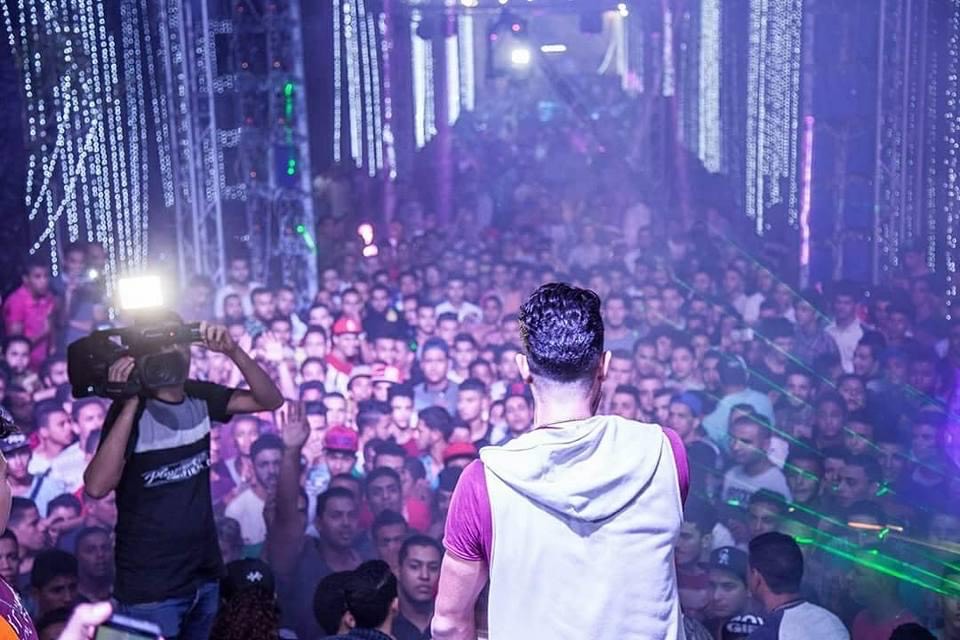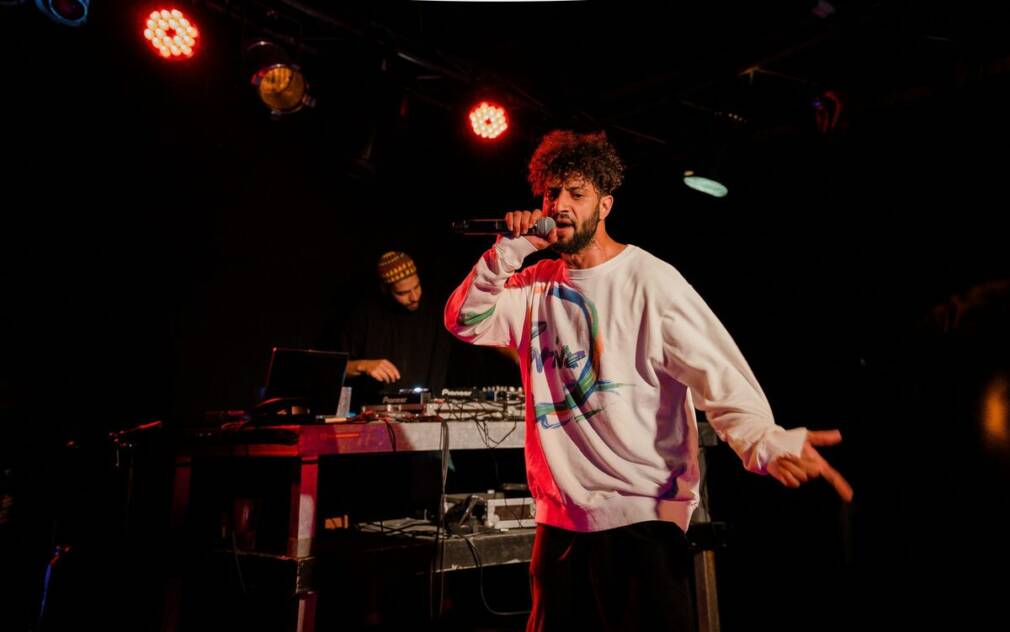From the streets of Cairo, where he began rapping, to the contemporary stages of Europe, listening to the story of rapper Shobra El General is an experience of overcoming and creation in exile. A nerve ending running through the furious trajectory of his life, mahraganat is how Shobra flexes his creative muscle.
Born in the chaos of revolutionary Egypt, this music, an improbable blend of loops drawn from the popular repertoire, incendiary lyrics and US rap culture fantasized by the Cairo street, has accompanied Shobra since he was a child. “I started rapping in 2002, I was eleven or twelve at the time,” recalls the artist. “I was working in a small store in Cairo at the time, renting out cassettes for weddings. Back then, I was helping out with the technical side of things, and I started playing tunes a year later. At the time, it was shaabi music.” Shaabi, which literally means “popular” in Arabic, is a musical genre that emerged in the working-class districts of Cairo in the 1970s. By extension, the word shaabi refers to anything associated with the working class. Coupled with the codes of US rap – trendy in 2000 – it is an essential component of the mahraganat phenomenon: “at the same time, my friends and I were following the whole old-school American hip hop scene, Nas, Jay-Z, Pac, Snoop, Dre of course,” confides Shobra. “Eminem, The Game, DMX, Ja Rule, Busta Rhymes later on. We listened to them a lot, and completely fantasized about their lives. Which didn’t go down too well in the neighborhood, as you can imagine. It was too new, too flashy compared to the very traditional view of those who didn’t know this movement, so we were pretty much frowned upon. At the same time, we were very much influenced by local models. I’m thinking of pioneers like the Arabians Knightz and their leader, Karim Rush, as well as Mc Amin or Kordy, one of the first to import lowrider culture and the West Coast genre to Egypt.”
The sound of the street, and revolution
The term mahraganat (literally “festival” in Arabic) emerged shortly before 2011, and the events linked to the Egyptian revolution. “Before the advent of the genre, we were in a fairly traditional rap approach. We downloaded instrumentals from the Internet. In mahraganat, imagine that the three or four pioneers of the genre were recording directly with headphones, like those you could find in cybercafés at the time. Mahraganat was born in the streets. Very poor streets, where people were hungry.”
Ultra-spontaneous, impulsive and raw, stuffed with grime or saturated reggaeton, the genre was to shake up the small network of independent and autonomous rap in Cairo. “More and more young people started self-producing as well as producing. Initially, I covered the music of Amr Haha, the man who really created mahraganat.” The genre immediately became the sound board for a street in full rebellion against Hosni Mubarak’s autocratic rule: “When the revolution started, the whole generation started singing and rapping about insurrection, unrest and social injustice. Mahraganat depicted, in music, everything that was happening in the streets of Cairo.” Streets where the army had replaced the police. “The policemen took off their own uniforms for fear of reprisals,” recalls Shobra.

The local scene began to take shape. “At the time, it was made up of Sadat, Fifty, Dj Figo and, of course, Amr Haha, on the one hand, and the duo Oka & Ortega on the other… Everyone had exchanged their microphones for megaphones. Music was everywhere. mahraganat had become a real social medium, directly connected to the street.” Fans of the genre also made up a little urban legion. “The whole bourgeois and conservative fringe feared the movement for its uncontrollability and outspokenness, even its frank vulgarity. The working classes, on the other hand, loved it.“
From the streets to the studio
In the aftermath of the revolution, mahraganat and Shobra took to the studio. “When the unrest calmed down, let’s say, we incorporated electronic music into our productions, again under the influence of Amr Haha. Autotune also arrived at that point,” explains the rapper. “The main players in the movement had simply acquired more experience, and we had a better grasp on production and recording tools. As a result, the tracks became better. The bass was better, the lyrics more polished.“
The scene then welcomed new activists, influenced by the European electronic scene among others. “Molotof is one of those who inflated and amplified the sound of productions in the mahraganat. This producer had his ears turned towards English clubbing, so he brought techno inspirations that hadn’t existed in the scene before. This openness he also applied to the public as well as to the players on the scene, since at the turn of 2017, he opened up the genre to women. From the outset, he had this strategy of being able to bring girls into the movement, which at the time wasn’t easy. Now, largely thanks to him, young female rappers are joining the mahraganat.”

One of the other mutations to date for Shobra comes from Atlanta, and it was imported to Egypt by another rapological mutant: Young Thug. “In 2017, we discovered Young Thug. As well as Future, and all the Atlanta rappers,” confides Shobra El General. The arrival of trap in the Egyptian rap scene would bring about new changes. A trend that would further accentuate mahraganat artists’ relationship with the studio. “Initially, our music was destined for the street, as well as the stage. It was all about energy. The arrival of trap slowed everything down. We couldn’t rap as fast as we used to on trap prods, because no one was on time, so it didn’t work. The flow had to slow down, and the addition of trap to our music forced me to say less in the end. At the same time, I didn’t want to bite the Americans, as had happened in Cairo. Some local rappers started doing Young Thug in Arabic. And some still do. While the illusion may have worked here in Egypt, I knew that European audiences would not be fooled.“
From Cairo to Paris
Shobra went on to develop a new form, directly influenced by Southern rap, but greatly enriched by “pure Shaabi samples. My kicks are recorded directly on the streets of Cairo.” The European electronic scene also plays an important role in his work. “Touring at the Fusion Festival opened me up to dubstep, drum’n’bass and techno. My next move will be to work with these sounds.” Today, many describe his music as a form of trap shaabi, a rapological monster that would have dipped into Young Thug’s Slime without forgetting his proletarian… but with Cairo roots. “Today, the artistic model that dominates the Egyptian scene oscillates between Atlanta and Dubai. It’s a shame. It even goes so far as to value those who rap in English, to the detriment of Arabic. After all these changes, and all the turmoil this scene has been through, we need to take a firmer artistic stance once again.” The General has spoken.




